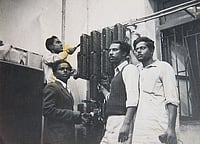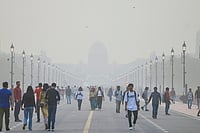
The song turned out to be a deafening, explosive symphony, the finale of Beethoven's Choral sustained over three hours, the anguished cry of Guru Dutt's Jala Do in Pyaasa , stirring the nape for years after, each time the memory revisits. The Bandit Queen stunned everyone into breathless silence. Even after it ended and the lights came on, for long moments no one moved. And then a standing ovation was delivered.
At that point, pristine from the director's palette, not yet set upon by the armies of media and morality, it was a flaming raw wound of a film, compelling and repelling examination at the same time, lodged as it was firmly in the classic artistic terrain of shifting values and relative truths. To the discerning viewer—bored senseless by the sheer unreality of Bollywood cinema—this was clearly a path-breaking film. The Bandit Queen is not, as all Bollywood films are, a comic book created to tease and sate adolescent fantasies, starring hugely bloated yet un dimensional lovers and avengers. In real life people do not speak in speech bubbles; in real life people do not sing and gyrate around trees. These are realities of the comic book, and of Bollywood cinema.
On the other hand, violence, numbing, desensitising violence is a routine aspect of our lives. People die in burglaries, in riots, in acts of terrorism. Caste and language wars have claimed hundreds of lives over the years. In rural India, rape has been used time and again more as a statement, an act of supremacy and subjugation, than as a psychotic hunt for plea-sure—even now the celebrated Bhanwari Devi wages the battle of her humiliation. Dacoity too, once claimed its share of victims. And this is what Phoolan Devi's story is all about: about the circumstantial horrors that can befall a woman in a male-dominated, caste-ridden society. And more particularly, how the singular woman can wreak vengeance in folklorish fashion.
This, then, is the story Shekhar's film attempts to tell; and it is, compared to the Bollywood comic strips, a piece of powerful literary fiction, striving to approximate reality, unafraid to engage with uncomfortable questions, possessed of a seamlessness and integrity. Like a good book, it begs an adult sensibility and rewards it.
But it has stuck in our craw. Or at least in that of the moral police. Yet one more time we have chosen to opt for a puddle-deep interpretation of morality. For a society that claims a 5000-year-old antiquity and boasts of a flourishing artistic refinement when the western world was still savage, we continue to display a comic book sensibility, forever getting into knots about banning books and films, which any adult should be able to negotiate routinely. The toiling masses are inevitably credited with less commonsense than they possess. Whereas the truth is that, squeezed from all sides, vulnerable to the incalculable vagaries of misfortune, commonsense is the commoner's greatest stock-in-trade, his premier weapon in the war for life.
If people can, against all odds, find jobs, marry, look after their parents, educate their children, combat deprivation, disease, humiliation; if they manage to travel, build houses, buy television sets; if they can cope with callous policemen, bad politicians and worse weather, what makes us presume them incapable of dealing with a film or a book. It is difficult to imagine anyone rising from a film to embark on a fornicating spree. Or putting down a book to go slit a few throats. Surely, the rational faculties of the Indian adult are no poorer than of his counterparts elsewhere.
In its kicks and kudos saga, The Bandit Queen has collected some strange abuse. One school of dissenters has repeatedly attacked it for denigrating women. This is particularly ridiculous, for what the film does is not to denigrate women but to portray the denigration of women. And that, presumably, makes a case for the opposite: for correction and reform, not oppression and abuse.
?Then there is the endless controversy about the brutality, the nudity, and the profane language. But that is the film. It can be assumed, even without visiting the Chambal, that dacoits do not speak like Lucknowi nawabs, nor settle blood-feuds over rounds of chess. Howdoes one sanitise and dilute reality when the aim is to represent it with power and vividness? Schindler's List must show the Nazis gassing millions, even though it may discomfit present-day Germans. Platoon cannot but be splattered with torn limbs and gore. As for the rape: to be shown to be brutal, it must be shown as brutal. There is no room for exonerating strategies there. And the nudity: one fleeting scene where an abject Phoolan, stripped to her skin, is forced to walk through the village square. Seamless in the narrative, and a pivotal scene, it requires particular deprivation to link it with tumescence.
There have been good, angry films earlier—by Saeed Mirza, Govind Nihalani and so on—but most have dealt with the existential angst of the individual. This goes beyond. More importantly, it is the first major, credible biopic (bio-graphic film) on a living legend made by an Indian. This is a powerful genre, used brilliantly by western filmmakers—its latest representatives being Braveheart and Nixon . Shekhar's film has been hailed by critics everywhere, and the peerless Barry Norman named it one of the best five in the world last year. Lakhs of Indians have seen it, and presumably not left the halls degraded beasts; it has ridden controversy to more money than Channel Four ever dreamt of; yet it continues to convulse. We do not censor our papers for violence, we do not censor Khajuraho for its orgiastic sculptures, our art and fiction are allowed to say what they will, why do we insist on reducing our cinema to infantilism. Even in the worst case, the profanities of The Bandit Queen are tolerable, the excesses of art not worrying: what is to be feared are the facile orthodoxies of smooth-faced morality marshals, for they patrol the road that ends in the frozen silence of the gulag.





















